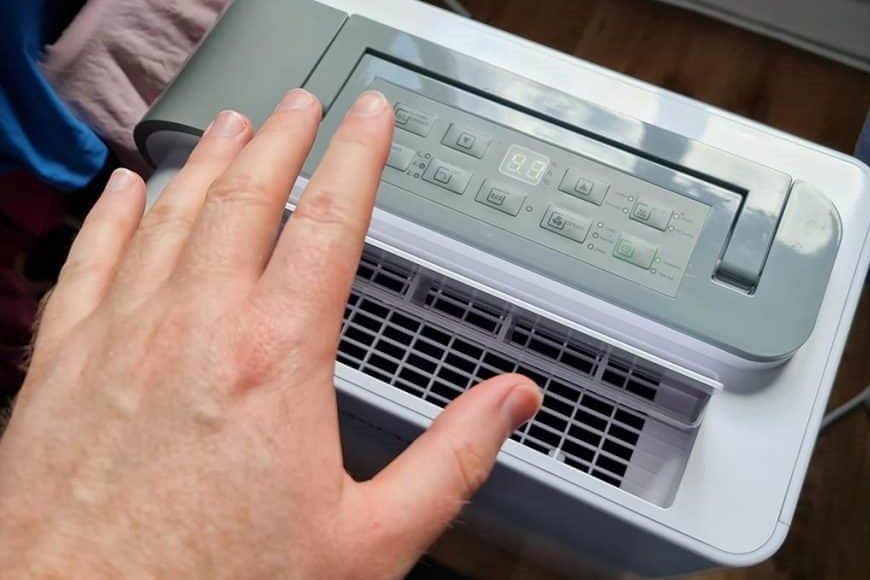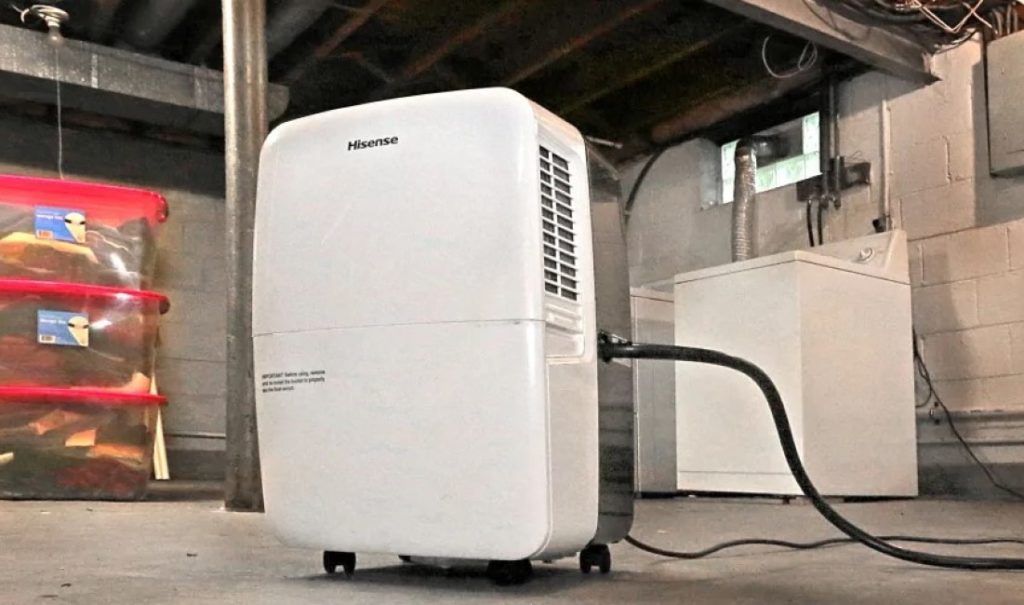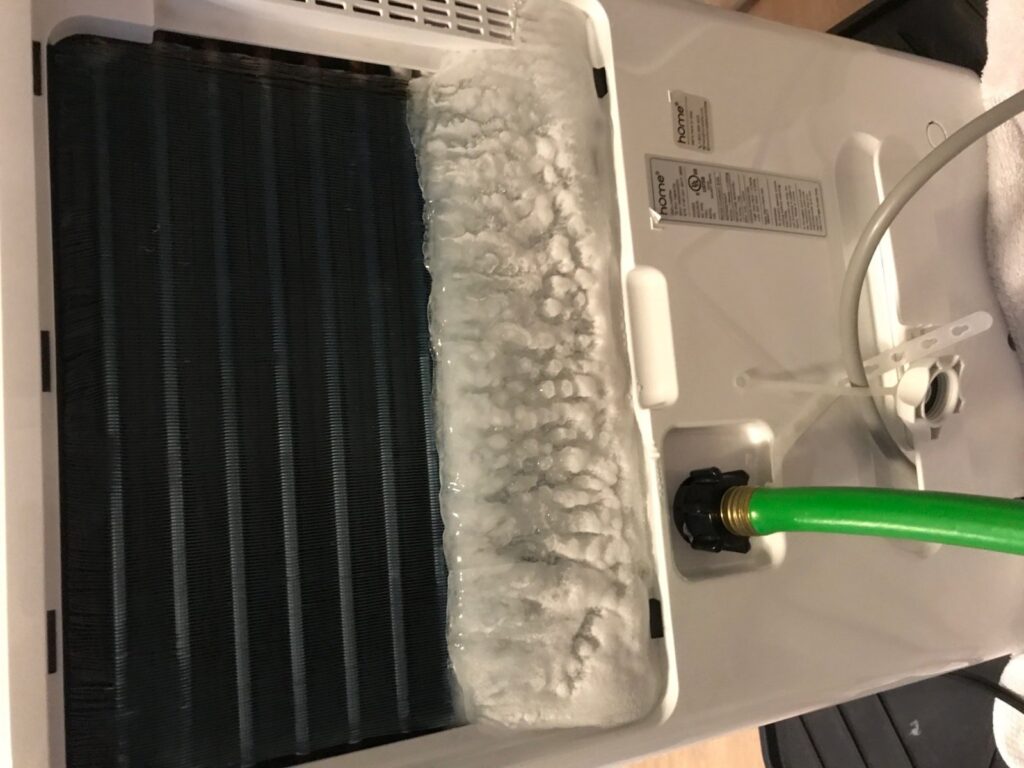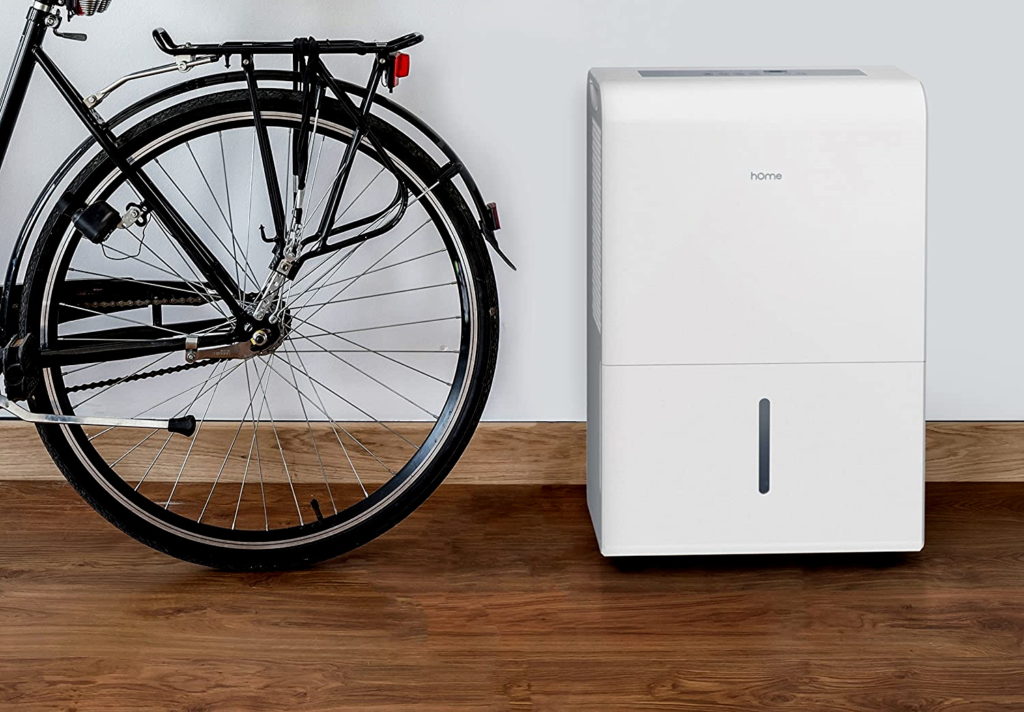

What a privileged time we live in! You can customize your life and improve almost all parts or your daily routine. Even what goes on in your bathroom. What is the one thing that gets you down? For many, it’s the undesirable odors that often prevail, no matter how hard you work on keeping the place clean and hygienic. It’s not your fault! The very nature of bathrooms leads to high humidity and yes, sometimes even mold. But you do have a solution in the form of one of the best dehumidifier for bathroom products listed below. Pick the right one, and you’ll get back control of that room in your house as well.
But what will make it your best option? We looked at the essential features such as performance, but also practical aspects. You need to identify the best choice for your scenario. Capacity and coverage area determine whether you’ll be satisfied with the effects once you plug it in.
To ensure you’re making the best choice we asked input from plumbers, construction specialists as well as interior decorators. They tested a vast range of products available on today’s market and below we list the top nine picks. We focused on picking the best ones across many niches, so you’re guaranteed to find one for your unique use, layout, and budget. Our Editor’s Choice is the Keystone 30 Pint Dehumidifier . To help you make the right choice, we added a comparison chart, in-detail product reviews, and a buying guide at the end. Become an instant pro, pick the right one and solve that nagging problem today!
More features: removable dust filter; transparent water level indicator; 24-hour timer
This one could improve regarding looks, but we do love the square design: no space is wasted, and you can place it flush against the wall when not in use.
At a mid-range price, you get a few handy features of which the drain option is many consumers’ favorite. It’s also fitted with a removable tank so use that method if it’s not possible to position it near a drain. Don’t worry; the unit will switch off when the tank is full.
With this one you even get setting options so decide if you need normal, Turbo or Auto Defrost setting. Just note that it’s not the quietest item on our list and in Turbo you’ll get more noise, pushing the decibels above what you usually get from air conditioner units. At normal, there’s not much disturbance, so it’s appropriate for average household use.
This one has some automation features such as the 24-hour timer. The fact that it remembers your settings after a power outage is also quite impressive for a reasonably priced unit.
One drawback is the fact that the dehumidifier itself creates some heat for the room if used for a long time continuously. If you live in a hot, humid location, this could make the bathroom itself uncomfortable. They should also rethink the basin as it’s tricky to get it back in after emptying.
Still, it’s effective, draws a lot of liquid from the air and offers many options. That’s what the modern consumer wants, right?
More features: washable air filter; LCD interface; adjustable fan
What struck us about this small dehumidifier is the many ways in which it makes life a little easier for homeowners. You may have to carry it around which is why the manufacturer added a carry handle. Want to stay in control of the situation? That’s why you’ll love the LCD display. In today’s world consumers love staying informed and your dehumidifier shouldn’t be any different. You can adjust quite a lot such as the fan speed which you don’t get on all models. Don’t worry about the screen’s light bothering you at night—you can even adjust its brightness.
Along with this you can use a drain hose or just empty the water tank. Having options is another way of being user-friendly. You can also use it for longer than some others as the filters are washable.
Another important user-friendly approach is ensuring everybody’s safety. If this gadget tips, gets bumped or tilts because a dog or your toddler pushes it over it will immediately shut down. An extremely helpful feature for young families, as even a sudden movement will have this effect. Therefore, you can leave it operating for many hours in a row without worrying of any possible emergencies.
This is a desiccant dehumidifier, and this helps you if you’re operating in very cold weather. It’s also an eco-friendly approach, perfect for those who prioritize the environment.
It’s an excellent balance between performance and dimensions, but just be prepared: it’s a bit pricey.
More features: 2 settings; timer function
Here’s another design you can proudly put on display while it regulates your home’s humidity. This is also a practical option to use in hotel rooms as it won’t spoil the aesthetics. It simply looks fantastic, modern and can even add some character to your home décor.
But it’s not all looks with this one: it works well, pulling water out of the air at an impressive pace. It even has practical features such as the timer: pick four or eight hours so you don’t have to remember to switch it off. And don’t worry, unlike some others on this list the Crane model doesn’t run hot; it’s safe, and it won’t heat up the room while it works.
One more area where this one trumps many others is its sound level: you can carry on with your tasks, and this one won’t disturb you too much.
Note that it does come at a higher price tag than some other smaller units; you’re probably paying more for style than capacity. This is most suited for small areas, not a large open space. However, use it in the right environment and you’ll see (feel) the difference within 48 hours.
For those looking for a healthier lifestyle, this could be one of your tools as it contains anti-microbial material—it will prevent bacterial growth by over 95%. It’s one of the best dehumidifier for bathroom mold products on the market today. Perfect to keep your family healthy.
More features: three speed settings; removable washable filter; 4-hour on/off timer and control lock
We ranked this almost 30-pint dehumidifier high regarding portability because it has all the necessary features to easily move it where you need it: handles in front as well as on the sides, matched with caster wheels that easily navigate over floors and carpets. For the family that needs help in various rooms, this is a practical solution.
The other features impress too as you have multiple options, operated via the user-friendly interface on top. You can pick your preferred humidity setting, and the machine will do the rest. Even after reaching your desired level, it keeps working, monitoring the air. If humidity rises, it will kick back into action. In order to monitor humidity, the fan switches on every now and then. For some users this can be irritating, but this is a very quiet machine, so it’s no deal breaker.
It’s quite effective, so it’s best to position it near an outlet and use the drainage system. However, the tank is also easily accessible if you need to empty it yourself. This is one of the few machines that have splash guards so you won’t accidentally ruin your outfit just because it’s time to empty your dehumidifier.
We even adore the overall design as it looks sleek and modern, ready for offices, homes and professional applications too.
Although slightly bigger than some other models here it’s Energy Star rated, so it won’t elevate your utility costs too much.
More features: requires no batteries; contains crystals that indicate when the unit reaches its capacity
What an innovative approach! This one makes it easy to find a spot for it since you don’t need a power source or even a drain. No, not even batteries. It uses the revolutionary approach of trapping moisture inside the silica gel crystals. When it’s filled to capacity, the crystals will change color and you simply need to take it to a well-ventilated space where you’ll plug it in for renewing.
The downside is that you lose out on up to ten hours of usage each time it’s full. That’s how long it takes to renew. This means you have to plan well and check the coloring often.
The slim design means you can place your dehumidifier out of the way so it doesn’t affect floor space or aesthetics. Because it doesn’t need a power outlet to work, you have many options of where you want to use your new gadget. It does have a limit of working for up to 333 square feet only, but the unit does its job effectively for closets and most bathrooms.
A warning: while it renews you can’t leave it in for too long. It’s known to become extremely hot which can damage the unit or your wall, so keep an eye on this one. Also, keep in mind that the unit is designed for small enclosed spaces, so it suits tiny, not extremely damp bathrooms and bathroom cabinets best.
The dehumidifier should operate well for ten years, but good news is you can simply replace the crystals and use it even longer. This is our Budget Pick regarding price, but it will also save you money on utility costs in the long run.
More features: comes with a DC adapter; ultra-quiet operation
Here is an excellent example of what the Peltier technology brings us: this unit runs quietly because it doesn’t have a noisy compressor and don’t worry, it’s still effective.
Of course, this is a very compact design, so it won’t work in large spaces. However, it’s the perfect choice for small bathrooms of up to 162 square feet. Of course, you can also use it for other similar-sized rooms if needed, as an RV dehumidifier, for instance.
Despite it being compact it still showcases high-level safety features such as an auto shut-off when the tank is full. You can also glance at the LED indicator which will keep you up to date with water levels.
It’s super light compared to the others on our list, making it one of the best portable dehumidifier for bathroom options around. Of course, it has limited capacity, but it’s safe for children to carry around and won’t weigh down your luggage if you need one when going on a camping trip. The simple operation with just one button also makes it easy to teach little ones to switch it on after they used the bath or shower.
Being small it’s a budget-friendly option too; just make sure it will work for the space you plan on using it in.
This is our other option for drying your closets without robbing you of much space. Bonus: the low noise means it can run all night if needed.
More features: ultra-quiet peltier technology; removes up to 8.8 ounces per day
If space is a problem, brands like KEDSUM have you covered. This is a super small design but that doesn’t mean you compromise on efficiency. This is one of the best compact dehumidifier for bathroom options because it works! Hard!
Of course the water tank is a bit smaller than others, but it’s likely you’ll use this in a compact room too, so it’s sufficient for those scenarios. Just note that it doesn’t have a drain function: you’ll have to empty it yourself.
A small, light unit like this is ideal if you need to transport it from room to room. You can solve the humidity problem throughout the home, without lugging around a huge device. Of course, it’s also perfect if you plan on storing it from time to time – any closet will have a corner to squeeze this into.
This is one of the quietest items you’ll find on our list, as it can work at 35dB. That’s impressive enough to leave it running even at night.
It’s a simple design without many features, but many consumers prefer the one-button operation as it’s user-friendly. It does have auto shut-off, making it safe to use.
Unfortunately, the KEDSUM dehumidifier also creates some hot air. Still, the small size means this won’t be too bothersome.
More features: low energy consumption; operates at 42 dB
Of course, you don’t want handy appliances ruining the aesthetics of your room. With this one there’s no chance of that as it has a sleek black casing. You’ll add a modern feel to any room you use it in. Afloia outdid itself in creating the best dehumidifier for the bathroom with no vent but also the most striking. No wonder it’s so high on our list.
Inside you’ll find impressive details too. The high tech design operates reasonably quiet and we appreciate the location of the water tank—situated in front it’s easy to remove for emptying.
For the environmentalists out there: this one is an energy-saving unit with auto shut-off. The only thing we would have liked to see is a drain hose so manual emptying isn’t necessary. Perhaps in a future upgrade? The light that shows you when it’s full is a very helpful feature.
This high tech machine is easy to use since you simply press a button. And it’s fast! Collects ¼ cup in just a few hours!
Thanks to the low noise, this is one you can use in the office too. It won’t spoil aesthetics for visitors, and it won’t disturb anyone. The slim design means you can even place it on top of a counter if you don’t want to use floor space. It’s light enough to handle easily, and all you need is a power outlet. All of this makes the high price tag worth it.
More features: two speed settings; automatically switches off when the tank is full and the full indicator light lights up
This is one of the larger units, and we’re quite impressed by its capacity. That makes it appropriate for various medium-sized rooms in the house as well as large bathrooms.
It’s smart too as it will shut off when the tank is full. You can operate other features via the easy-to-understand panel with one-touch buttons. Customize your drying process by using the timer, and the two fan speeds help you manage drying according to your needs.
While it dries out the air, it will also purify it thanks to an ionizer air purification system. It will help the fight against bacteria throughout your home. 2-in-1 gadgets are always nice to have since they save you money and space.
The dehumidifier is also very quiet as well. You can use it in your bedroom when needed without fearing that it will interrupt your sleep.
It does require some maintenance as the filter needs washing and wiping occasionally. Luckily this is an easy process with the filter simply popping off the unit. Consumers who are after compact compressor type dehumidifiers will appreciate this design.
Our last comment: we love the wheels! Easily push it to where you need its services with no unnecessary pressure placed on your back as you don’t have to carry anymore.
Ready to improve your lifestyle? There’s no reason to live with that moldy smell any longer. And we’ll help you pick the ideal dehumidifier for bathroom or other applications, to enjoy optimized results in your space. Just follow our handy reference guide below.
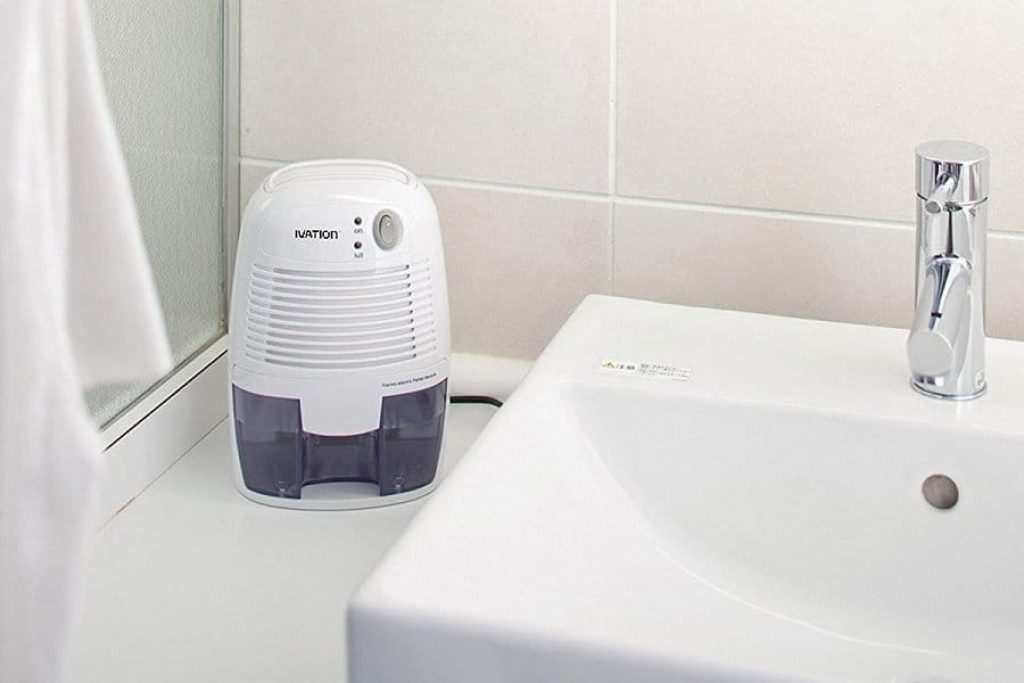
Much of shopping for your best portable dehumidifier for bathroom use is matching your scenario to a unit’s capabilities. Therefore, before you start shopping determine your need.
Firstly: how large an area should the machine work for? And don’t forget to consider alternative scenarios too. If you plan on using it elsewhere in a room much larger than your bathroom (such as the kitchen), then adjust your goal. Coverage area describes the size of the space the particular dehumidifier can effectively dry out. Make sure you’re not disappointed by misjudging your needs. For example, the KEDSUM model will never live up to the same performance as the Keystone, but they’re both brilliant at what they’re designed to do.
Secondly: what moisture levels must your new humidifier cope with? If you’re going to hang clothes in your bathroom during the day, this will increase the humidity levels, and this scenario is much different than merely dealing with moisture from showers.
Thirdly: what is it like outside? Living in areas with high humidity levels such as near the sea will require your appliance to work even harder.
In general, the experts advise you to rather go for a unit that’s slightly more powerful than what you really need.
To assist consumers, experts such as the AHAM (Association of Home Appliance Manufacturers) place handy tools online to help you determine your need. Search for charts and tables that will guide you in determining your needs.
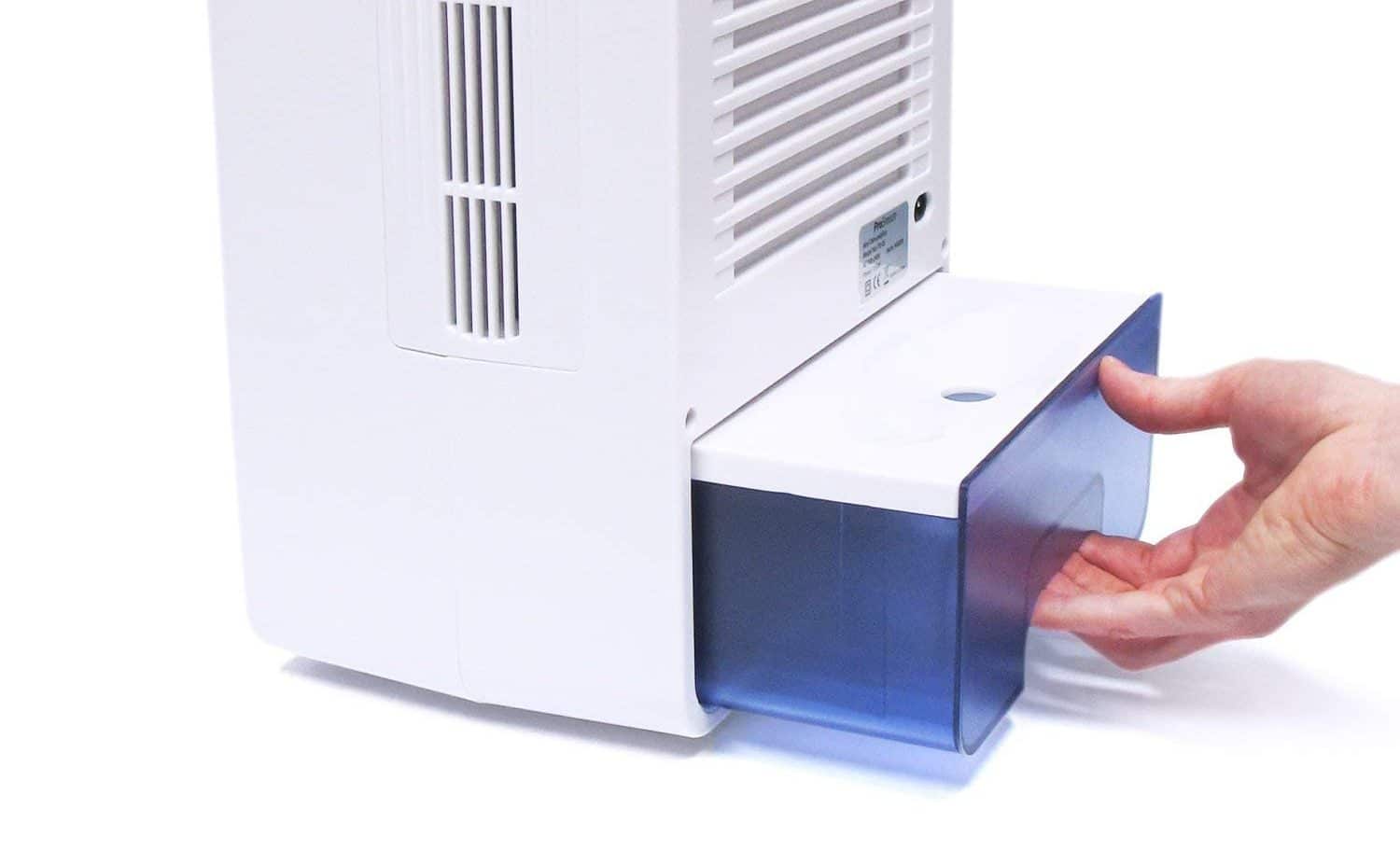
However, note that the water tank size may influence how big your machine will be and how much it costs. If you only have limited space available or you’re shopping on a budget, this should be your number one priority.
Modern appliances are designed to match consumer needs, so to limit manual emptying, many models have drain hoses. This means the water in the tank will automatically flow out. What’s the problem here? It means that you’re limited in options of where you’ll position the unit. It must be near a sink or shower drain. But yes, this makes life even more effortless!
Luckily, most units that have this option also allow for emptying a tank, such as the Frigidaire 22-Pint above. Just make sure you buy one that will work for your room’s layout.
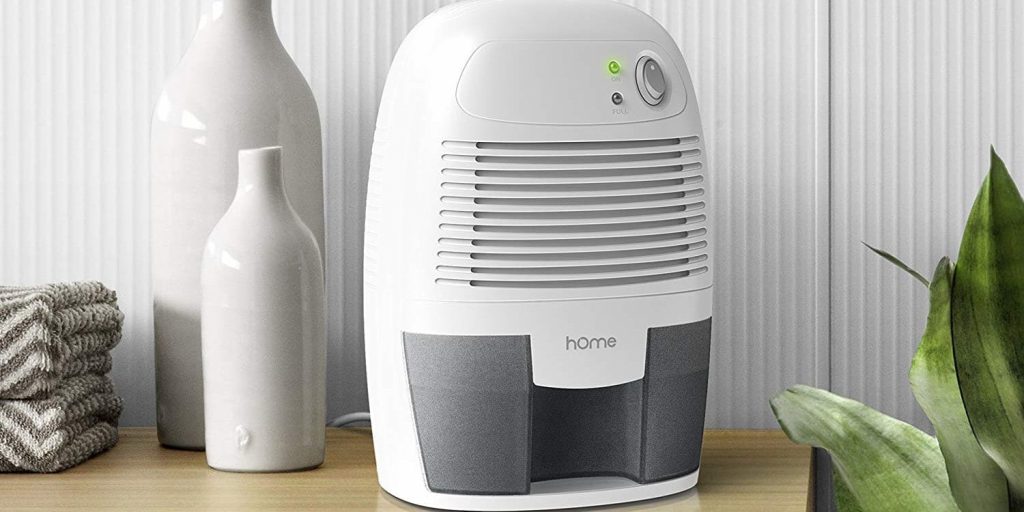
Also consider units that allow you to pick how humid you want the air to be. As we said, a high tech unit such as the Ivation can help you customize even this part of your life.
This is a number one complaint many brands get from consumers, but you can’t blame them if you forget to research this beforehand. Depending on the type you pick, prepare yourself for some noise the moment you switch on your dehumidifier.
Luckily, thanks to technological advances there are types of dehumidifiers that now work quietly. Instead of gas or compressor types you can get one using Peltier technology. This is silent technology so you can leave yours on at night as well. The Eva-dry’s renewing method also comes in handy for this reason.
For some this will surely be a luxury option: pick a silent one, so you have a quiet home. Alternatively, settle on a noisier one if you want the job to be done much faster. Then again if you have small kids who need their naps, you don’t want home appliances waking them, so investing in a silent unit is once again worth it.
Portable. That’s what most of the units above are supposed to be. That means you must be able to carry (or push) and store them easily. Unless you plan on leaving yours out at all times, in the same place, consider this:
Now pick a size and weight that won’t make your new, handy appliance more cumbersome than helpful.
You don’t want to lose your new appliance just as you’re starting to enjoy it, so make sure you get an impressive warranty as can be seen on top of the range items such as the Keystone’s five-year promise.
Just note the warranty guidelines: As this item works with both water and electricity (creating a potentially dangerous situation that can lead to damage), you must use it within the brand’s parameters in order to claim that warranty.
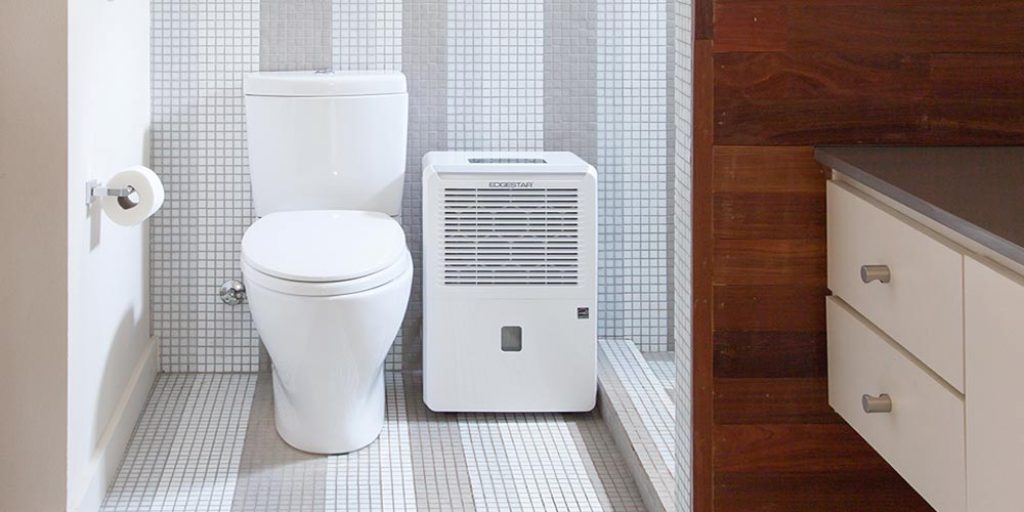
First of all, you should do an entire audit of your home setup. Did you know there’s a lot you can do to limit the humidity in your bathroom, even before your new dehumidifier arrives? Implementing these guidelines will give you better results, and along with your dehumidifier there’s no reason you’ll have mold problems again:
Science and technology will help you enjoy a fresh smelling, comfortable bathroom again. For us, the best dehumidifier for bathroom mold is the Keystone 30 Pint which impresses with its abilities. It can handle high humidity settings, and it works fast. The drain feature is also a valuable add on.
For families we suggest the Ivation 13 Pint as it’s so user-friendly and its many safety features will put your mind at rest for using it around children.
Crane USA Dehumidifier simply looks fantastic, modern and can even add some character to your home décor. But it’s not all looks with this one: it works well, pulling water out of the air at an impressive pace.
You can see there’s something for everyone to pick the best dehumidifier for the bathroom and other areas for your home and breathe easier from now on.


